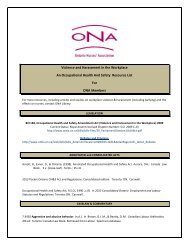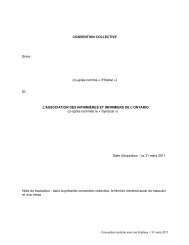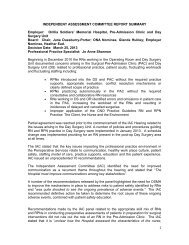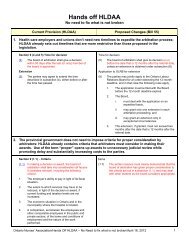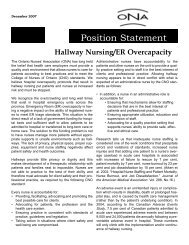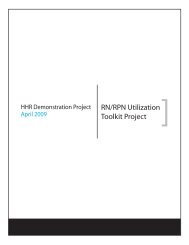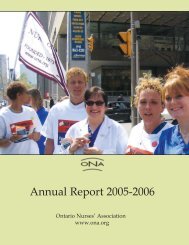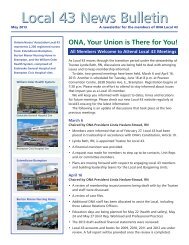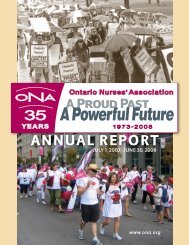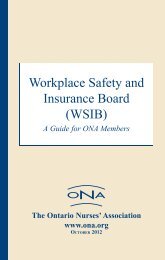Refusing Assignments: - local70
Refusing Assignments: - local70
Refusing Assignments: - local70
You also want an ePaper? Increase the reach of your titles
YUMPU automatically turns print PDFs into web optimized ePapers that Google loves.
Professional Obligations andLabour Relations Implications of<strong>Refusing</strong> an Assignment
OBJECTIVES• Recognize the professional accountabilitiesrelated to unsafe workload and patientassignments• Identify and interpret the differences betweenprofessional and employment obligations• Identify situations and conditions when you areunable to provide safe patient care• Understand your obligations to your employer• Manage your ability to meet your collegestandards2
WORKLOAD HISTORY“Workload has historically been an issue of concernfor Registered Nurses. Conflicts may arise betweennurses’ duty to obey their employer and accept allpatient assignments given to them and their duty tothe patients and the profession of providingappropriate care to each one.”CNA & CFNU Country Report for the InternationalCouncil of Nurses Workforce Forum, CNA, 2004, p. 103
COLLEGE OF NURSES OF ONTARIOCNO Practice Guideline - <strong>Refusing</strong> <strong>Assignments</strong> andDiscontinuing Nursing Services, 2009• The College of Nurses of Ontario (the College)frequently receives questions about whether nurses havethe right to refuse assignments or discontinue care toclients, and if doing so constitutes abandonment of clients.• These questions are often prompted by job actions orstrikes, requests to work overtime and unsafe workingconditions• Using an ethical problem-solving approach can help nursesconsider the relevant factors and work out the bestsolution.CNO Practice Guideline <strong>Refusing</strong> AssignmentAnd Discontinuing Nursing Services, 2009:3 4
CNO STATEMENTS• Employers are responsible for establishing a workingenvironment, including staffing, that supports safe,effective client care.• Nurses are accountable for providing safe, effective andethical care to their clients (College of Nurses ofOntario, 2004b).• To resolve conflicts between professional and personalobligations in a way that protects the public’s right tosafe care, nurses need to be aware of the relevantstandards and legislation and ensure that they considerall aspects of the situation.CNO Practice Guideline <strong>Refusing</strong> AssignmentAnd Discontinuing Nursing Services, 2009:35
CNO STANDARDSProfessional Standards, Revised 2002 : This document describes,in broad terms, the professional expectations for all nurses in everyarea of practice.A nurse demonstrates accountability by:• providing, facilitating, advocating and promoting the best possible carefor clients;• seeking assistance appropriately and in a timely manner;• taking action in situations in which client safety and well-being arecompromised; and• maintaining competence and refraining from performing activities forwhich she/he is not competent.In addition, a nurse in an administrator role demonstrates accountabilityby:• ensuring that mechanisms allow for staffing decisions that are in thebest interest of clients and professional practice; and• advocating for a quality practice environment that supports nurses’ability to provide safe, effective and ethical care.CNO Practice Guideline <strong>Refusing</strong> AssignmentAnd Discontinuing Nursing Services, 2009:4 6
CNO STANDARDSEthics: The ethics document describes the ethical values that are mostimportant to the nursing profession in Ontario.Nurses demonstrate regard for client well-being and maintaincommitments by:• using their knowledge and skill to promote clients’ best interests in anempathetic manner;• putting the needs and wishes of clients first;• identifying when their own values and beliefs conflict with the abilityto keep implicit and explicit promises and taking appropriate action;• advocating for quality client care; and• making all reasonable efforts to ensure that client safety and wellbeingare maintained during any job action.The Ethics document informs nurses of the need to recognize andfunction within their own value system, and the need to workcollaboratively with colleagues and promote an environment ofcollegiality.CNO Practice Guideline <strong>Refusing</strong> AssignmentAnd Discontinuing Nursing Services, 2009:4 7
LEGISLATION• The Nursing Act, 1991 includes regulations that define professional misconduct.Some of the definitions of professional misconduct may be relevant in situationsin which nurses refuse assignments or discontinue nursing services.• Although there is no specific definition of professional misconduct that includesthe word abandonment, the definitions can guide nurses on what mightconstitute professional misconduct related to refusing an assignment ordiscontinuing nursing services. Each situation would be assessed on its ownmerit.• The relevant definitions of professional misconduct in the legislation are foundin the following clauses.▫ 1 (1) Contravening a standard of practice of the profession or failing to meet thestandard of practice of the profession▫ 1 (4) Failing to inform the member’s employer of the member’s inability to acceptspecific responsibility in areas where specific training is required or where themember is not competent▫ 1 (5) Discontinuing professional services that are needed unless:• i. the client requests the discontinuation,• ii. alternative or replacement services are arranged, or• iii. the client is given reasonable opportunity to arrange alternative orreplacement servicesCNO Practice Guideline <strong>Refusing</strong> AssignmentAnd Discontinuing Nursing Services, 2009:49
LABOUR RELATIONS OBLIGATIONS• In labour law, there is a widely recognized principlecommonly referred to as "Obey Now, Grieve Later";• In situations where an Employer's actions or assignment ofwork could cause a nurse to act in a way, that the nursebelieves to be in conflict with the CNO's standards ofpractice, the nurse needs to make her Employer aware thatin her view, the direction/assignment conflicts with CNOstandards.• The best way to do this is to first, verbally, inform themanager or charge nurse, but then follow up in writing andspecifically use the ONA PRWRF.10
REFUSAL RELATED TO OCCUPATIONALHEALTH & SAFETY SITUATIONS• In Ontario, the OHSA establishes the right to refuse unsafe work without fear ofreprisal. According to Section 43 of the Act, the circumstances in which a workercan refuse include circumstances where the worker has reason to believe that:▫▫▫▫▫Any equipment, machine, device or thing the worker is to use or operate is likely toendanger himself, herself or another workerThe physical condition of the workplace or the part thereof in which he or she worksor is to work is likely to endanger himself or herself; orThe physical condition of the workplace is in contravention of this Act or theregulations and such contravention is likely to endanger himself, herself or anotherworker.Workplace violence is likely to endanger himself or herself; orAny equipment, machine, device or thing he or she is to use or operate or thephysical condition of the workplace or the part thereof in which he or she works or isto work is in contravention of this Act or the regulations and such contravention islikely to endanger himself, herself or another worker.• Section 43 also sets out the procedures to be followed when a worker refusesunsafe work.ONA, A Guide for ONA Members,“My Right to Refuse Unsafe Work”, Oct. 2010:112
CONT’DStatutory Limits on ONA Members’ Right to RefuseAs stated, for most of ONA’s members, the right to refuse unsafework is restricted. The workers subject to the restriction includethose working in:▫ “(i) a hospital, sanatorium, nursing home, home for the aged,psychiatric institution, mental health centre or rehabilitation facility,▫ (ii) a residential group home or other facility for persons withbehavioural or emotional problems or a physical, mental ordevelopmental disability,▫ (iii) an ambulance service or a first aid clinic or station,▫ (iv) a laboratory operated by the Crown or licensed under theLaboratory and Specimen Collection Centre Licensing Act, or▫ (v) a laundry, food service, power plant or technical service or facilityused in conjunction with an institution, facility or service described insubclause (i) to (iv).”ONA, A Guide for ONA Members,“My Right to Refuse Unsafe Work”, October 2010:1 13
CONT’D• These employees still have a right to refuse, but not:(a) when a circumstance…is inherent in the worker's work or is a normalcondition of the worker's employment; or(b) when the worker's refusal to work would directly endanger the life,health or safety of another person.[Section 43 (1), OHSA]Here is one example that the MOL uses to explain the exemption:• An experienced medical lab technologist could not, in the course of his or herregular work, refuse to handle a blood sample from a patient with an infectiousdisease.• But the technologist could refuse to test for a highly infectious virus whereproper protective clothing and safety equipment are not available.Dealing with infection is likely “inherent in the worker’s work” in a health carefacility, but doing do without proper protective equipment, where such exists isnot “inherent.”ONA, A Guide for ONA Members,“My Right to Refuse Unsafe Work” October 2010:214
CURRENT WORKPLACE ENVIRONMENTS• Nurses are faced with:• Staffing Issues (short staffed/skill mix)• Increased client acuity• Increased number of patients• Hallway beds/patients• Overcapacity protocols15
PRC PROCESS VS. CNO PROCESSONA PRC Process1. Discuss workload concernswith co-workers on unit.Develop strategies to meetpatient care needs2. Seek help from nursingleaders responsible fortimely resolution3. Continue to escalate throughthe chain of commandCharge Nurse Manager Supervisor/manager on call Unit Director Chief Nursing Officeror management on callCNO Process1. Identify issues, values,resources and conflictingobligations2. Identify the options anddevelop a plan/approach3. Implement the plan4. Review, discuss and evaluatethe processCNO Practice Guideline <strong>Refusing</strong>Assignment And Discontinuing NursingServices, 2009:616
DECISION TREE FOR UNSAFEASSIGNMENTS/WORKLOAD17
DECISION TREE FOR UNSAFEASSIGNMENTS/WORKLOAD18
PROFESSIONAL RESPONSIBILITYWORKLOAD PROCESS & PROFESSIONALMISCONDUCT• Choosing to continue an unsafe assignment withoutinforming the employer through the ProfessionalResponsibility Workload Process, could potentially lead toprofessional misconduct.• Nurses need to be aware of the labour relationsimplications that may follow if they are found guilty ofprofessional misconduct.• Each situation is decided on its own merit by the College ofNurses.• By following the PRC process you are meeting yourprofessional responsibility.19
PROFESSIONAL MISCONDUCT?• “Some nurse managers and administrators, faced withstaff shortages have assumed that staff nurses areabandoning clients and committing professionalmisconduct if they refuse overtime or extra shifts.”• “In fact, this is not the case. The misconductregulation outlines nurses’ responsibilities while onduty. For example, during an assigned shift, nurseshave a responsibility to remain on the ward/facilityOR ensure clients are cared for if they do leave.”College of Nurses of Ontario, Communique/March 2002, “You Asked Us”. 2002, p.1320
ABANDONMENTDiscontinuing Nursing Services“Abandonment occurs when a nurse has accepted anassignment and discontinues care without:• Getting the client’s permission;• Arranging a suitable alternative or replacement service; or• Allowing a reasonable opportunity for alternative orreplacement services to be provided.A nurse who discontinues services without meeting the aboveconditions could be found guilty of professionalmisconduct.”Nurses are accountable for their own actions and decisionsand do not act solely on the direction of others.<strong>Refusing</strong> <strong>Assignments</strong> and DiscontinuingNursing Services, CNO, 2009, p. 521
SCENARIO # 1No Replacement StaffJoanne, an RN in a long-term care facility, has 45 minutes left on hershift when the director of resident care asks her to work the nextshift. The replacement nurse has called in sick, and there is noone to replace Joanne if she leaves.This is the third time this month that Joanne has been asked to workan extra shift. She is tired and upset.She believes that her employer is not doing enough to attract morestaff. Also, she was up most of the previous night with her sickdaughter and is exhausted. She is still concerned about her daughter.The last time she worked an extra shift she promised herself that shewould not stay again, but she is concerned about thesafety and well-being of the residents.CNO Practice Guideline <strong>Refusing</strong> AssignmentAnd Discontinuing Nursing Services, 2009:1022
Floating to Another UnitSCENARIO # 2Noreen works on the medical unit of a small communityhospital. Upon arriving for her scheduled shift, thesupervisor asks her to float to the obstetrics/gynaecologyunit because the census on her unit is low.Noreen is anxious because she has never worked inobstetrics/gynaecology and feels she is not competent toprovide care on that unit.A colleague tells Noreen to refuse the assignment.CNO Practice Guideline <strong>Refusing</strong> AssignmentAnd Discontinuing Nursing Services, 2009:1223
SCENARIO # 3Workload/Patient AssignmentLouise reports to work and is informed that there has beena sick call that can not be replaced. Louise has work thepast 2 days and knows the patients on her unit are highlyacute and complex and having an increased patient loadwill not allow her to practice safely and meet her patientsneeds.Louise is worried that this assignment will subject herpatients to an unacceptable level of risk and unsafe andinadequate care, as well as an increased risk for harm toherself in trying to manage the assignment.How can she address this concern and meet her CNOstandards?24
SUMMARY• All nurses are accountable for taking action in situations inwhich client care is compromised.• This accountability includes identifying and advocating forstrategies to minimize and resolve situations that couldresult in clients being left without needed nursing services.• Nurse managers and administrators can demonstrateleadership by advocating for and implementing strategiesrelated to:▫ Care delivery processes▫ Leadership▫ Organizational Supports▫ CommunicationCNO Practice Guideline <strong>Refusing</strong> AssignmentAnd Discontinuing Nursing Services, 2009:825
REFERENCESAmerican Nurses Association (2009). Patient Safety: Rights of Registered Nurses WhenConsidering a Patient Assignment Position Statement. Retrieved fromhttp://www.nursingworld.org/rnrightspsCanadian Nurses Association Code of Ethics for Registered Nurses (2008) Ottawa.Canadian Nurses Association Position Statement (2009). Patient Safety, Ottawa.College of Nurses of Ontario, Pandemic Scenarios. Retrieved from http://www.cno.org/en/learnabout-standards-guidelines/educational-tools/pandemic-planning/planning-for-an-influenza-pandemic/Disagreeing with the Plan of Care Practice Guideline (2009). College of Nurses of Ontario, Toronto.Duty to Care Fact Sheet(2011). College of Registered Nurses of Manitoba.Duty to Provide Care Practice Standard (2007). College of Registered Nurses of British Columbia.Ethical Decision-Making in Times of Crisis (2003). Communique, College of Nurses of Ontario,Toronto. P.8-9.<strong>Refusing</strong> a Shift and Abandoning Clients What am I accountable for? (2001). Communique.College of Nurses of Ontario, Toronto. p.11.<strong>Refusing</strong> <strong>Assignments</strong> and Discontinuing Nursing Services (2009). College of Nurses of Ontario,Toronto.Staff Shortages. (2002). Communique, You Asked Us. College of Nurses ofOntario, Toronto. p.13.27



